Experience the charm of Lao Chai Village with Vietpower Travel, where the terraced rice fields of Muong Hoa Valley meet the vibrant culture of the Black Hmong and Giay people. Located just 7–8 km from Sapa Town, this peaceful village offers a true glimpse of mountain life through guided treks, local homestays, and cultural encounters. Each itinerary connects travelers with nature and tradition, blending authentic experiences with community-based tourism in northern Vietnam.
Lao Chai Village lies in Muong Hoa Valley, about 7–8 kilometers southeast of Sapa Town. The village has over 100 households with around 542 residents, mostly Black Hmong and Giay ethnic groups.
Lao Chai is known for its peaceful setting:
.jpg)
Lao Chai welcomes visitors all year, but the scenery changes dramatically with each rice season. The three best times to visit are during the water-pouring, green, and harvest periods.
During late spring, mountain water flows into the fields, turning the terraces into shining mirrors. Lao Chai is part of the largest and highest terraced system in Sapa. It is an excellent time to see local farmers planting rice and to capture reflections of clouds and mountains across the valley.
By midsummer, the young rice grows lush and vibrant. The weather is cool and pleasant, making trekking comfortable and photography rewarding. This is the best period for families or travelers who prefer fewer crowds and clear views of the valley.
In early autumn, the entire valley turns golden as the rice ripens. The air is filled with the scent of freshly harvested grain. Local markets and daily farming scenes make this the best time to visit Lao Chai Village for photographers and culture seekers. Because it is the peak season, booking homestays early is recommended.

The Lao Chai trekking route stretches about 7–8 kilometers from Sapa town center and is one of the most scenic trails in northern Vietnam. On weekends and holidays, the village welcomes up to 600 visitors, while weekdays see around 100–200 travelers . Despite its popularity, the route remains calm and refreshing, offering a balance between nature, culture, and gentle adventure.
This is the signature trail connecting several Sapa Villages, allowing trekkers to move gradually from the high slopes of Y Linh Ho to the open valley of Lao Chai, and then continue to Ta Van. The landscape shifts from mountain ridges to terraced fields, dotted with traditional houses and grazing buffalo.
Travelers can stop along the way to meet locals, learn about rice farming, or simply enjoy the view of Muong Hoa Valley stretching below.
The trek usually takes between two and four hours, depending on weather and fitness level. The terrain is mostly gentle, with occasional slopes and narrow paths crossing small bridges. It is suitable for all ages, including families and first-time hikers. Vietpower Travel provides guided options to ensure safety and cultural interaction along the route.

Key sights along the trail include:

Lao Chai Village is more than a scenic stop — it’s a living community where tradition and tourism coexist naturally. Visitors have the chance to engage directly with local families and learn about the cultural depth of the Black Hmong and Giay people.
Tourism has become a reliable source of income for many families. On average, each household earns about VND 20–30 million per month (approximately USD 813–1,220) through homestays, handicrafts, and guided activities.
A typical day starts early, with villagers tending rice fields or preparing goods for visitors. In the afternoon, guests can join weaving sessions or help prepare meals using locally grown vegetables. Despite modernization, the rhythm of daily life remains rooted in community cooperation and respect for nature.

The artistry of ethnic costumes and handmade fabrics remains a defining aspect of Lao Chai’s identity. To the north, Lo Lo Chai Village in Ha Giang has been officially recognized for its “Art of Decoration on Costumes” as a National Intangible Cultural Heritage (2022).
Lao Chai shares this same spirit of preservation. Many Hmong women still use natural indigo dye and traditional batik tools to create intricate geometric patterns. These crafts are more than souvenirs—they carry the stories of generations and help sustain local livelihoods.

Festival – Roong Poọc Festival (Giáy people)

Lao Chai is surrounded by nature, history, and spiritual landmarks that reflect the essence of northern Vietnam’s Sapa Villages. Each site offers its own perspective on the valley’s culture and landscape.
Located along the base of Hoang Lien Son Mountain, Muong Hoa Valley is famous for its layered rice terraces reflecting sunlight like mirrors. This is the largest and highest terraced system in Sapa., stretching through Lao Chai and Ta Van. There is no separate entrance ticket here; visitors pay a shared fee at the Muong Hoa ticket gate.

Set near the lower valley, the Sapa Ancient Stone Field includes about 200 engraved stones discovered in 1925. The carvings depict old rituals, farming scenes, and spiritual symbols of ancient tribes.

A rustic bamboo bridge crossing the Muong Hoa Stream connects Lao Chai and Ta Van Villages. It is a peaceful spot for photography and a glimpse of rural daily life.
This rope-style bridge spans over the Ý Linh Hồ area, creating a stunning view of the valley. From May to June, the bridge becomes even more beautiful during the butterfly season.

A small temple honoring “Co Be Muong Va,” a protective spirit in the Mother Goddess religion. Locals visit to pray for luck and harvest blessings.

|
|
|
|
|
|
|
|
|
|
|
|
|
|
|
|
|
|
|
|
|
|
|
|
|
|
|
|
|
|
|
|
|
|
|

Dining in Lao Chai combines simple ingredients with mountain flavors. Most restaurants and family kitchens serve dishes made from locally grown produce and free-range livestock.
|
|
|
|
|
|
|
|
|
|
|
|
|
|
|
|
|
|
|
|

To enter Lao Chai Village and the nearby Muong Hoa Valley, visitors need a combined entrance ticket that also covers the Ancient Stone Field.
Tickets can be purchased at the Muong Hoa Valley gate, located about 1.5 km from Sapa Stone Church on Muong Hoa Road. The ticket includes access to Lao Chai, Ta Van, and Y Linh Ho Villages.
Lao Chai is about 7–8 kilometers southeast of Sapa Town. Transportation options are flexible and easy to arrange:
Travel time is approximately 20 minutes by car or 40 minutes by motorbike along Muong Hoa Road. The road is narrow in some sections, so driving carefully is advised, especially during the rainy season.
Duration: 4 hours
Route: Sapa Town → Y Linh Ho → Lao Chai → Return to Sapa
Morning
Late Morning
Afternoon

Duration: 6–7 hours
Route: Sapa → Y Linh Ho → Lao Chai → Ta Van → Return to Sapa
Morning
Lunch
Afternoon

Duration: 2 Days / 1 Night
Route: Sapa → Y Linh Ho → Lao Chai → Ta Van → Return to Sapa
Day 1 – Morning
Day 1 – Afternoon
Day 1 – Evening
Day 2 – Morning
Day 2 – Afternoon

Exploring Lao Chai Village offers travelers a genuine look into Vietnam’s mountain life—where golden terraces, warm homestays, and ethnic traditions create lasting memories. Book your cultural trek today with Vietpower Travel, your trusted tour operator for authentic experiences across Vietnam Tourist Attractions.
Contact Information: